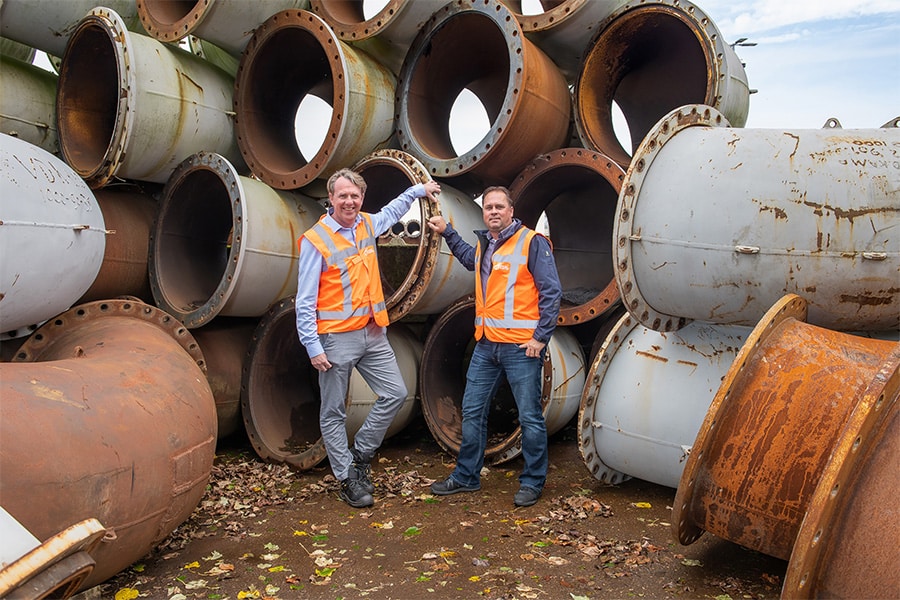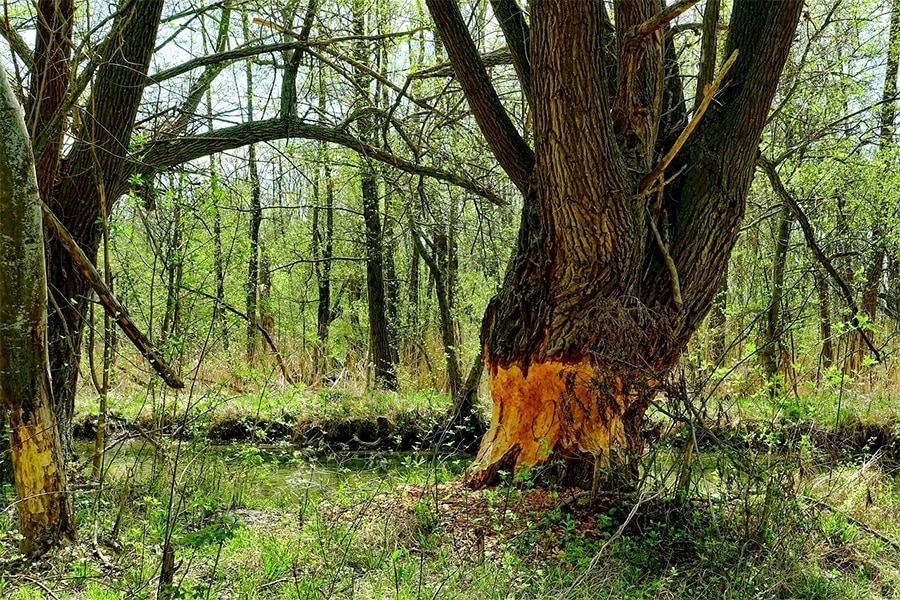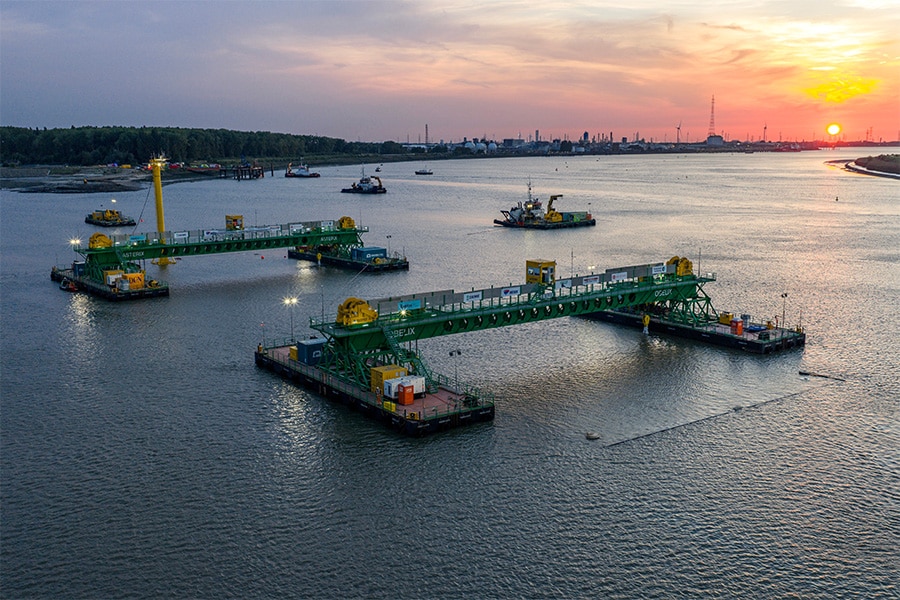
Dike reinforcements Ooijen-Wanssum sustainable and effective
Fugro moves with water in changing role
With the great floods in Limburg that shook the entire country in 1993 and 1995, people are well aware of the fact that living and working alongside water involves risks. We were recently reminded of this by the extremely high water levels in the Meuse River in July of this year. The Limburg Water Board is working together with Rijkswaterstaat, the High Water Protection Program (HWBP), Area Development Ooijen-Wanssum and Consortium Grensmaas, among others, to reinforce and construct dikes along the Meuse.
In December 2020, the Area Development Ooijen-Wanssum was completed. Implementation of the project was in the hands of Mooder Maas: a combination of contractors Dura Vermeer and Ploegam. This area development offers a definitive solution to the high-water problems in this area. For its implementation, a search was made for flood defenses that fit into the originally undyked landscape of northern Limburg. This was realized with two new types of dikes: the Steilranddijk and the Hoge Gronddijk. Mooder Maas was able to realize the new dikes with area-specific materials that also achieved the sustainability objectives. The landscape design for this approach came from H+N+S Landscape Architects and the technical design came from Fugro. GWW magazine talks about this with Leo Zwang, project director at Fugro Netherlands.
The objectives of Area Development Ooijen-Wanssum
Flood protection against water levels that occur once every 250 years
Water level drop of 35 cm (at high tide)
Developing nature and landscape
Increasing livability in Wanssum
Space for new economic development
With the realization of the area development the area between Broekhuizen and Geijsteren is protected against high water levels of the Meuse. There is new space for entrepreneurs to develop, the center of Wanssum has become more livable due to the new bypass and a beautiful nature reserve of over 500 hectares has been realized: Maaspark Ooijen-Wanssum. In addition, a 35 cm drop in the water level at high tide will be realized, which will be noticeable as far away as Roermond.
Area Development Ooijen-Wanssum is an initiative of five governments:
Ministry of Infrastructure and Water Management/the Department of Public Works
Province of Limburg, Municipality of Venray, Municipality of Horst aan de Maas
Waterschap Limburg (Source: waterschaplimburg.nl)
As much as 20,000 tons less CO 2 emissions
Leo opens the talk, "The criteria for sustainability in hydraulic engineering are not yet clear. It is actually a catch-all term. Of course, water safety is essentially sustainable, but building dikes is not always good for the environment. The original plan involved excavation and disposal of 4 million cubic meters of soil. As a Geo-data specialist, we worked with H+N+S Landscape Architects to design sustainable dikes (see boxed text on page 13) that - although significantly wider - fit in much better with the environment. The width of the dike gave many more opportunities for shared use. By working with materials that were locally available, a 50% reduction in CO 2 emissions could be achieved. The soil was not disposed of now, but was assessed for strength with extensive laboratory testing by Fugro. The dike was simulated in a 300-meter wave trench and the soil from Ooijen was tested. The results proved that the material can be safely used for these dikes. The baptism of fire came last July when high water ravaged Limburg: the dikes at Ooijen-Wanssum withstood this with flying colors."
The tests done consisted of classical geotechnical tests, wave channel tests, stream channel tests and pinhole tests. These tests allowed the safety of the design to be proven. The seepage barriers in this project were constructed in clay instead of steel. By performing HPT-(A)MPT © probes, it was possible to prove that the seepage barriers could be short, which brought the clay construction into the picture. Sustainability was also gained in that area: reduced emissions, application of local materials, a future-proof design and the solution fits in beautifully with the environment.


Fugro's added value
Leo outlines the major difference between Fugro's old and new approach as a result of new contract forms: "We are asked to the table earlier to help think things through. When I started at Fugro, the project phases were fixed outside until execution and the contractor carried out the work according to specifications. Fugro provided measurement and consultancy services to water boards. That was very nice work, but new contract forms showed that more is possible. In the new contract forms, the contractors themselves sit at the design table. Fugro offers great added value in that process; by engaging us, all the technical possibilities can be explored and utilized. We often make these opportunities and possibilities visible as early as the tender phase. Apart from all the data, Fugro's people are extremely knowledgeable. For example, we knew at an early stage that the designs for Ooijen-Wanssum were feasible. By working innovatively, we can determine the feasibility of each project very early in the process. In terms of capacity and experience, we are truly distinctive as Fugro: the combination of measuring, advising and designing is strong. We will take all our knowledge and experience with us to new projects in the future."
"That we are now allowed to come up with innovations as early as the first project phase is new," Leo continues. "We are engaged from design to realization. By collecting data and approaching each project as a learning opportunity, we can apply our data and knowledge back to other projects. This also creates a good picture about the properties of certain types of soil in areas. This has led us to think about the structuring of the subsurface. How does the climate affect clay? An important question within climate adaptation, to which we are getting more and more answers."
The importance of digitization
"In the projects of recent years, moreover, we see a development in digitalization. This happens not only in data collection, but also in consulting and modeling. Every project shows us taking a step further. In addition, we work together with our partners to align digitalization processes ever better. Our goal is to make the design process not only more efficient, but especially faster, with a higher level of detail. This will also directly benefit the environment by optimizing the use of materials."

Left more beautiful than encountered
Leo agrees, that the landscape in the Ooijen-Wanssum project was left more beautiful than it was found. "This is how Fugro sees long-term sustainability: what we do must be sustainable and enhance livability. With Ooijen-Wanssum, it was not just about the dyke reinforcement, but about the development of the entire area. We included nature and the environment in a design that ensures improved livability. By applying different materials than usual, even the ecology has been additionally strengthened, which is visible, for example, in the nests of bank swallows in the steep slopes. A different principle in the dike design has created a new natural value. We are proud of the teamwork that enabled us to achieve this and won the Water Innovation Award in 2019. The new role we have taken on suits us, we are moving with the water as a company."
In conclusion, Leo says, "The plan took people with it. Local residents had a lot of input and everyone saw the natural added value. As a result, stakeholder management also went smoothly. The 'bottom line' is that sustainable does not necessarily have to be more expensive. It doesn't get much greener than Ooijen-Wanssum."
Steilrand dike and High Ground dike
For the implementation of Area Development Ooijen-Wanssum, we looked for flood defenses that fit into the originally undyked landscape of northern Limburg: The Steilrand dike reinforces the characteristic terraced landscape along the Meuse by creating a nature buffer with a steep edge in front. The natural buffer is allowed to develop dynamically, with natural erosion processes and vegetation determining its shape. Behind this nature buffer lies the actual flood barrier. This is concealed and serves to protect the area behind it from high water levels on the Meuse River. The classic design of a river dike with a clay lining including grass cover has been replaced here by a concealed dike body with a robust erosion buffer of clay. On the inner side of the dike, extra soil (over height) will be applied to the dike slope to allow the dike to merge into the sloping landscape and to enable shared use of the dike. At the High Ground Dike, too, the water barrier will be "packed" in a robust and future-proof manner by using an over-height on top of the dike and gentle slopes. (Source: Fugro)
Awarded prizes!
The Flood Protection Program project in Ooijen-Wanssum recently won the 2020 Golden Pyramid from the Ministry of the Interior.
Empire Prize
The Golden Pyramid is the national award for inspiring commissioning in architecture and area development. In addition to the trophy, the project receives 75,000 euros. Outgoing Minister Kajsa Ollongren of the Interior awarded the prize. This is already the third award for Ooijen-Wanssum. Previous awards received are the Spatial Quality Pluim 2018 and the Water Innovation Award 2019.
Heeft u vragen over dit artikel, project of product?
Neem dan rechtstreeks contact op met Fugro.
 Contact opnemen
Contact opnemen







